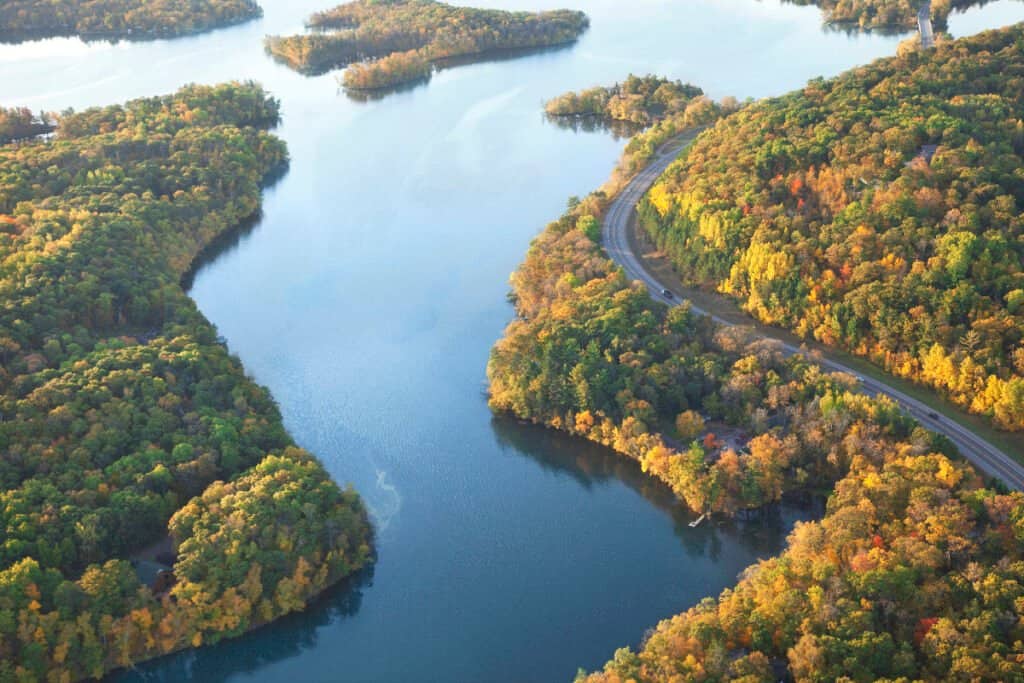The Mississippi River is famed for its natural beauty as well as its role in American history and industry. It is also the world’s third-largest river basin, covering approximately 1.2 million square miles of water from 31 U.S. states. The river also provides clean drinking water for millions of people and is home to a variety of animals, including fish, birds, amphibians, and even mammals.
Covering a distance of 3,766 kilometers, the Mississippi River is indeed the longest in North America, as it flows through ten different U.S. states, namely: Mississippi, Louisiana, Arkansas, Tennessee, Kentucky, Missouri, Illinois, Iowa, Wisconsin, and Minnesota. The Mississippi River flows through 20% of the United States. The river starts in Lake Itasca in Minnesota and ends in the Gulf of Mexico.
This river is also home to the most important varieties or species of fish, such as catfish, walleyes, suckers, carp, and garfish. There are also species of fish here that are caught for sport, such as the sauger, largemouth bass, smallmouth bass, northern pike, bluegill, and crappies. In short, this river has about 25% of all the fish species found in North America.
Despite all of the fascinating facts about the magnificent Mississippi River, its history and origin are full of bizarre and absolutely unique events. Even though we’ve only been on this planet for a short time, the river’s history and beginnings may be traced back millions of years ago, when even the earliest humans were yet to be discovered.
Origin Of The Mississippi River

The Mississippi River is famed for its natural beauty as well as its role in American history and industry.
©iStock.com/Kruck20
The Mississippi River is not exactly like how it was before the first humans ever evolved. Of course, it underwent not just a few but lots of environmental and historical changes before it became what we know today as the longest river in all of Northern America.
1.4 BILLION YEARS AGO
The Precambrian foundation of Illinois is made up of granite, a type of intrusive igneous rock located 2,000 feet below the surface in the north and 17,000 feet below in the south. During the Precambrian period, the base of Illinois was formed by the constant cooling of magma. This indicates that the state of Illinois was still submerged or did not exist. Unfortunately, the south of Illinois sunk into the Earth for hundreds of millions of years before it existed in history.
570 MILLION YEARS AGO
The State of Illinois had to spend most of its time underwater for several hundred million years. Sedimentary rocks started to form; this showed that a promising landmark would emerge from the water in a few million years.
360-286 MILLION YEARS AGO
Illinois became a shallow sea with a shifting coastline. Over a few million years, Illinois rose above sea level, preventing the creation of fresh sedimentary rock. The Mississippi River began to emerge when the supercontinent Pangea split apart and settled into its present places 208-144 million years ago.
Dinosaurs roamed most of Illinois throughout the Mesozoic era, which reigned 245-66 million years ago, and this had been established despite the lack of fossil evidence. This is due to the erosion and glaciations that had happened, removing any dinosaur fossil evidence from the area.

The Age Of The Mississippi River

Mountain building and shifting events make a significant contribution to reshaping and rebuilding river systems.
©Milen Mkv/Shutterstock.com
Of the many methods used to calculate the exact age of the Mississippi River, it’s hard to imagine that the river might’ve maintained its natural state through lots of environmental activity such as earthquakes, shifting of tectonic plates, eruptions, and other geological changes that occurred.
It is believed that the Rocky Mountains of the North were still being thrust upward as late as 40 million years ago. Mountain building and shifting events such as these make a significant contribution to reshaping and rebuilding river systems. Thus, many conclude that the Mississippi River was already in existence less than 40 million years ago.
It was then until the year 2020 that a team of researchers doing a geologic study on the rock formations around the Mississippi River concluded that the said river was actually three times older than many of us thought.
The researchers found samples that can be considered Cretaceous deposits at the southernmost tip of Illinois, at least 70 million years old. From then on, many concluded once more that the Mississippi River is 70 million years old.
The Mississippi River Now

The Mississippi River has become a perfect destination for tourists and locals who want to witness its wonders and wildlife.
©iStock.com/Willard
Today, the Mississippi River has become a perfect destination for tourists and locals who want to witness its wonders and wildlife. There are a lot of recreational activities and opportunities for visitors, such as biking, hiking, birdwatching, and even kayaking.
Water skiing was also invented right here in 1920, which is why it is available as a recreational activity for individuals who wish to improve their river experience. There are several attractions along the river, and visitors may simply drive along the Great River Road, which follows the Mississippi River’s route through ten states in the United States.
One of the highlights of the Mississippi River is its vast wildlife, as it is home to numerous species of animals; 360 species of fish, 326 species of birds, 145 species of amphibians, and 50 species of mammals.
Some of the animals found here other than fish species are:
- Otters
- Beavers
- Coyotes
- White-tailed Deer
- Black bears
- Mountain Lions
- Bald Eagle
- Great Egret
- Peregrine Falcon
- American Crow
- Bluebird
- Mussels
- Turtles
- Lizards
- Snakes
- Frogs
Many locals consider the Mississippi River a cultural and historical treasure. With its outstanding geological features and astonishing origin, it is no surprise why so many people have been aching to see its beauty with their own eyes. That is why tourist activity never seems to be out of the way now.
If you’ve ever wondered what lives at the bottom of the Mississippi River, you can find out in this article.
What Animals Live on The Mississippi River?
There is a rich and diverse array of wildlife that lives in and around the Mississippi River, including:
- Fish: The Mississippi River is home to over 300 species of fish, including catfish, carp, bass, and sturgeon. Some of these species, such as the paddlefish, are native to the river and can only be found in this specific ecosystem.
- Birds: The Mississippi River is an important migratory route for many species of waterfowl and shorebirds, including the American white pelican, the great blue heron, and the double-crested cormorant. The river is also home to many species of songbirds and birds of prey, such as the bald eagle and the osprey.
- Reptiles: The Mississippi River is home to several species of reptiles, including the American alligator, the Mississippi mud turtle, and the yellow-blotched map turtle.
- Mammals: The river and its surrounding wetlands provide a habitat for a variety of mammals, including muskrats, beavers, river otters, and several species of bats.
- Amphibians: The Mississippi River and its tributaries provide critical habitats for several species of frogs and salamanders, including the American bullfrog and the green tree frog.
These are just a few examples of the many species that live and thrive in and around the Mississippi River. The river and its surrounding wetlands provide critical habitats for many species and support a complex and interdependent ecosystem that is important for the health and stability of the region.
The photo featured at the top of this post is © Milen Mkv/Shutterstock.com
Thank you for reading! Have some feedback for us? Contact the AZ Animals editorial team.






